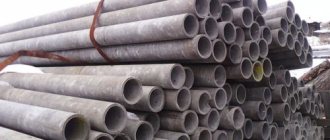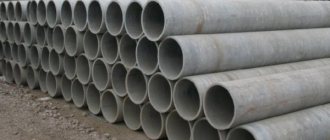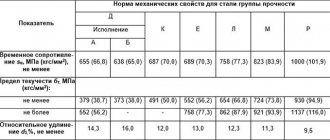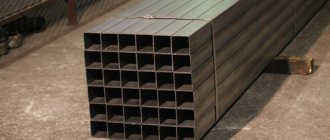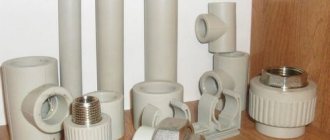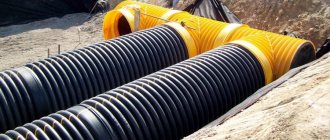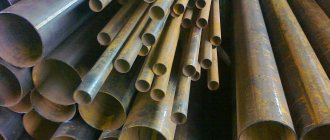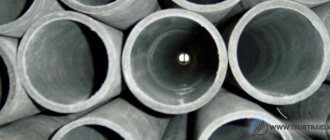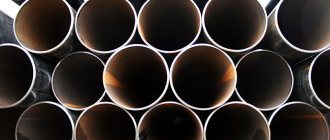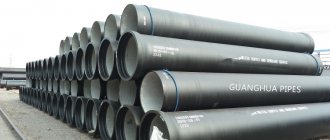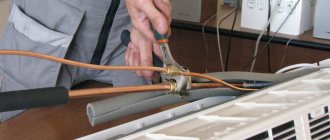Electrical wiring is a very important part of the communications that take place in a room. Its reliable protection and the correct selection of materials for hiding wires and cables are a guarantee of safety and long-term use. Often, corrugated polymer products are used as leading channels. Such pipes are manufactured in accordance with GOST, have all the required characteristics and provide adequate protection.
Corrugated pipes are universal products that are used in a wide variety of construction areas
BRANDS AND SIZES
1.1. Depending on the properties of the original plastic compound, the tubes are produced in the brands listed in Table. 1.
Table 1
| Tube brand | Brand of polyvinyl chloride plastic compound according to GOST 5960 | Raw material recipe | Applicability in static state |
| TV-40 | I40-13 | 230/1 251/1 | At temperatures from minus 40 °C to plus 70 °C |
| I40-13A | 8/2 | ||
| TV-40T | — | 230T | At temperatures from minus 40 °C to plus 70 °C |
| TV-40A | IT-105 | T-50 | At temperatures from minus 40 °C to plus 105 °C |
| TV-50 | — | 355 | At temperatures from minus 50 °C to plus 70 °C |
| TV-50-14 | I-50-14 | E 50-1 | The same, with improved insulating properties |
| TV-60 | I60-12 | E 60-1 | At temperatures from minus 60 °C to plus 70 °C |
Note. The indicators of polyvinyl chloride plastic compound of formulations 230T (tropical) and 355 are given in the Appendix.
(Changed edition, Amendment No. 1).
1.2. The tubes are produced in the sizes indicated in the table. . The length of the tubes should not be less than 5 m.
table 2
mm
| Inner diameter | Wall thickness | ||||
| Nom. | Prev. off | I version | II version | ||
| Nom. | Prev. off | Nom. | Prev. off | ||
| 0,50 | ±0,10 | 0,30 | ±0,10 | — | — |
| 0,75 | ±0,10 | 0,30 | ±0,10 | — | — |
| 1,00 | ±0,20 | 0,40 | ±0,10 | — | — |
| 1,50 | ±0,25 | 0,40 | ±0,10 | — | — |
| 1,75 | ±0,25 | 0,40 | ±0,10 | — | — |
| 2,00 | ±0,25 | 0,40 | ±0,10 | 1,00 | ±0,20 |
| 2,50 | ±0,25 | 0,40 | ±0,10 | — | — |
| 3,00 | ±0,25 | 0,40 | ±0,10 | 1,00 | ±0,20 |
| 3,50 | ±0,25 | 0,40 | ±0,10 | — | — |
| 4,00 | ±0,25 | 0,60 | ±0,10 | 1,20 | ±0,20 |
| 4,50 | ±0,25 | 0,60 | ±0,10 | 1,20 | ±0,20 |
| 5,00 | ±0,25 | 0,60 | ±0,10 | 1,20 | ±0,20 |
| 6,00 | ±0,30 | 0,60 | ±0,10 | — | — |
| 7,00 | ±0,50 | 0,60 | ±0,10 | — | — |
| 8,00 | ±0,50 | 0,60 | ±0,10 | — | — |
| 9,00 | ±0,50 | 0,60 | ±0,10 | — | — |
| 10,00 | ±0,50 | 0,70 | ±0,10 | — | — |
| 12,00 | ±0,50 | 0,70 | ±0,10 | — | — |
| 14,00 | ±0,50 | 0,70 | ±0,10 | — | — |
| 16,00 | ±0,80 | 0,90 | ±0,10 | — | — |
| 18,00 | ±0,80 | 0,90 | ±0,10 | — | — |
| 20,00 | ±1,00 | 1,15 | ±0,20 | — | — |
| 22,00 | ±1,00 | 1,15 | ±0,20 | — | — |
| 25,00 | ±1,00 | 1,15 | ±0,20 | — | — |
| 30,00 | ±1,30 | 1,40 | ±0,25 | — | — |
| 35,00 | ±1,30 | 1,40 | ±0,25 | — | — |
| 40,00 | ±2,00 | 1,75 | ±0,25 | — | — |
| 50,00 | ±2,00 | — | — | 4,5 | ±0,80 |
1.3. Depending on the wall thickness of the tube, versions I and II are produced. Tubes of version II have a thickened wall. The theoretical mass of 1 m of tube is given in the Appendix.
1.4. By agreement with the consumer, it is possible to manufacture tubes of other sizes with the standard for maximum deviations in accordance with Table. from other brands of plastic.
1.5. The symbol of the tube consists of the designation of the type and brand according to table. , a number indicating the diameter of the tube according to table. , tube colors according to table. , varieties and designations of this standard.
An example of a symbol for a TV-40 tube with an internal diameter of 4 mm, black, premium grade:
Tube 305 TV-40, 4, black, premium grade GOST 19034-82
For tubes of version II, the wall thickness is additionally indicated.
An example of a symbol for a TV-40 tube with an internal diameter of 4 mm, version II, thickness 1.2 mm, premium black:
Tube 305 TV-40, 4×1.2, black, premium grade GOST 19034-82
It is allowed to indicate a recipe in an example of a symbol.
(Changed edition, Amendment No. 1).
1.6. The OKP code for each brand, depending on the diameter, grade and color according to the All-Union Classifier of Industrial and Agricultural Products, must correspond to that specified in the appendix.
APPENDIX 2 (for reference). Theoretical weight of 1 m of PVC tube
APPENDIX 2Informative
| Nominal tube size, mm (inner diameter x thickness) | Theoretical mass of 1 m tube, g, brand | |||
| TV-40; TV-40T; TV-50-14 | TV-50 | TV-60 | TV-40A | |
| 0.5x0.3 | 0,97 | 0,92 | 0,9 | 0,93 |
| 0.75x0.3 | 1,27 | 1,21 | 1,19 | 1,23 |
| 1x0.4 | 2,26 | 2,15 | 2,11 | 2,18 |
| 1.5x0.4 | 3,06 | 2,92 | 2,87 | 2,96 |
| 1.75x0.4 | 3,47 | 3,3 | 3,24 | 3,35 |
| 2x0.4 | 3,87 | 3,69 | 3,62 | 3,74 |
| 2x1 | 12,09 | 11,53 | 11,31 | 11,69 |
| 2.5x0.4 | 4,68 | 4,46 | 4,37 | 4,52 |
| 3x0.4 | 5,48 | 5,23 | 5,13 | 5,3 |
| 3x1 | 16,12 | 15,37 | 15,08 | 15,58 |
| 3.5x0.4 | 6,29 | 5,99 | 5,88 | 6,08 |
| 4.0x0.6 | 11,12 | 10,6 | 10,4 | 10,75 |
| 4x1.2 | 25,15 | 23,98 | 23,52 | 24,31 |
| 4.5x0.6 | 12,33 | 11,76 | 11,54 | 11,92 |
| 4.5x1.2 | 27,57 | 26,28 | 25,79 | 26,65 |
| 5x0.6 | 13,54 | 12,91 | 12,67 | 13,09 |
| 5x1.2 | 29,99 | 28,59 | 28,05 | 28,98 |
| 6x0.6 | 15,96 | 15,21 | 14,93 | 15,43 |
| 7x0.6 | 18,38 | 17,52 | 17,19 | 17,76 |
| 8x0.6 | 20,8 | 19,83 | 19,45 | 20,1 |
| 9x0.6 | 23,22 | 22,13 | 21,71 | 22,44 |
| 10x0.7 | 30,19 | 28,78 | 28,24 | 29,18 |
| 12x0.7 | 35,83 | 34,16 | 33,51 | 34,63 |
| 14x0.7 | 41,48 | 39,54 | 38,79 | 40,09 |
| 16x0.9 | 61,31 | 58,44 | 57,34 | 59,25 |
| 18x0.9 | 68,56 | 65,36 | 64,13 | 66,26 |
| 20x1.15 | 98,04 | 93,45 | 91,69 | 94,75 |
| 22x1.15 | 107,31 | 102,29 | 100,36 | 103,71 |
| 25x1.15 | 121,21 | 115,54 | 113,37 | 117,15 |
| 30x1.4 | 177,19 | 168,9 | 165,73 | 171,25 |
| 35x1.4 | 205,4 | 195,8 | 192,11 | 198,52 |
| 40x1.75 | 294,49 | 280,72 | 275,44 | 284,62 |
| 50x4.5 | 988,52 | 942,29 | 924,57 | 955,39 |
TECHNICAL REQUIREMENTS
2.1. Tubes are manufactured of the highest and first grades in accordance with the requirements of this standard, according to technological regulations approved in the prescribed manner.
2.2. The outer and inner surfaces of the tubes must comply with the requirements of GOST 17675.
Metal inclusions are not allowed. On the outer surface of the tube, small foreign inclusions, heterogeneity of the material, slight roughness and marks from the forming tool are allowed, which do not cause local changes in the dimensions and properties of the tubes established by this standard.
(Changed edition, Amendment No. 1).
2.3. The tubes are made painted or unpainted. The color of the painted tubes must correspond to that indicated in the table. .
Table 3
| Brand | Color |
| TV-40, TV-40T, TV-50-14, TV-60 | White, black, grey, brown, red, pink, orange, yellow, green, light blue, cyan, purple |
| TV-40A | Black, grey, brown, pink, burgundy, orange, green, blue |
| TV-50 | Black |
2.4. In terms of electrical insulation and physical and mechanical properties, the tubes must comply with the standards specified in Table. 4. Water absorption and electrical parameters of polyvinyl chloride plastic tubes after exposure to chemical reagents are given in Appendix 4.
Table 4
| Indicator name | Standard for the brand | Test method | |||||||||||
| TV-40 | TV-40T | TV-40A | TV-50 | TV-50-14 | TV-60 | ||||||||
| Top grade | 1st grade | Top grade | 1st grade | Top grade | 1st grade | Top grade | 1st grade | Top grade | 1st grade | Top grade | 1st grade | ||
| 1. Specific volumetric electrical resistivity, Ohm cm, no less, under the conditions of GOST 6433.1: | According to GOST 6433.2, GOST 17675 and clause 5.6 of this standard | ||||||||||||
| 6(15-35) 45-75M (15-35) 45-75 | 1 · 1012 | 1 · 1012 | 1 · 1011 | 1 · 1011 | 2 · 1012 | 2 · 1012 | 1 · 1010 | 1 · 1010 | 1 · 1014 | 1 · 1013 | 1 · 1012 | 1 · 1011 | |
| 6(15-35) 45-75 ÷ 1(70) 20M (70) 20 | 1 · 1010 | 1 · 1010 | 1 · 109 | 1 · 109 | Not defined | 1 · 109 | 1 · 109 | 1 · 1012 | 1 · 1011 | 1 · 1010 | 1 · 109 | ||
| 2. Electric strength, kV/mm, no less, in accordance with GOST 6433.1: | According to GOST 6433.3, GOST 17675 | ||||||||||||
| 6(15-35) 45-75M (20) transformer oil | 15,8 | 15 | 15,8 | 15 | 15,8 | 15 | 15 | 15 | 15 | 15 | 15 | 15 | |
| 3. Electrical strength at low temperatures, kV/mm, no less, in accordance with GOST 6433.1: | According to GOST 6433.3, GOST 17675 | ||||||||||||
| 6(15-35) 45-75 ÷ 2 (-60) M (20) transformer oil | 16 | 10 | 12 | 10 | 10 | 10 | 12 | 10 | 12 | 10 | 12 | 10 | |
| 4. Electrical strength in conditions of high humidity, kV/mm, no less, under the conditions of GOST 6433.1: | According to GOST 6433.3, GOST 17675 | ||||||||||||
| 6(15-35) 45-7524 (20) 95M (20) transformer oil | 15 | 10 | 15 | 10 | 13,4 | 10 | 10 | 10 | 10 | 10 | 10 | 10 | |
| 5. Electrical strength at elevated temperatures, kV/mm, no less, in accordance with GOST 6433.1: | According to GOST 6433.3, GOST 17675 | ||||||||||||
| 6(15-35) 45-7548 (105) 20M (20) transformer oil | 12 | 10 | 12 | 10 | — | — | 12 | 10 | 12 | 10 | 12 | 10 | |
| 6(15-35) 45-7548 (120) 20M (20) transformer oil | — | — | — | — | 10 | 10 | — | — | — | — | — | — | |
| 6. Tensile strength, MPa (kgf/cm2), not less | 16,3 (170) | 15,3 (160) | 16,3 (170) | 15,3 (160) | 13,7 (140) | 11,8 (120) | 13,0 (133) | 9,8 (100) | 14,7 (150) | 11,8 (120) | 9,8 (100) | 9,8 (100) | According to GOST 11262, clause 5.9 of this standard and GOST 17675 |
| 7. Elongation at break, %, not less | 220 | 200 | 220 | 200 | 250 | 180 | 220 | 200 | 180 | 120 | 280 | 240 | According to GOST 11262, clause 5.9 of this standard and GOST 17675 |
Notes:
1. (Deleted, Amendment No. 1).
2. The standard according to subparagraph 2 for TV-40A tubes with a diameter of 50 mm must be at least 10 kV/mm.
(Changed edition, Amendment No. 1).
SAFETY REQUIREMENTS
3.1. When exposed to temperatures above 175 °C for a long time, tubes can emit small amounts of hydrogen chloride, the maximum permissible concentration of which in the environment is no more than 5 mg/m3. Hazard class - 3 according to GOST 12.1.007.
3.2. Production premises must be equipped with local exhaust general ventilation.
3.3. When an open flame is brought in, the tubes light up without an explosion, but when removed, they go out. When burning, they heavily pollute the room. The tube belongs to the combustible group, to the subgroup of flame-resistant ones according to GOST 12.1.044. If a fire occurs, extinguish using all fire extinguishing means. In this case, a gas mask with a grade B filter or an insulating gas mask according to GOST 12.4.034 is used indoors.
3.4. When testing tube samples for electrical parameters, the safety requirements in accordance with GOST 12.1.019 must be observed.
(Introduced additionally, Amendment No. 1).
Properties of corrugated pipes
GOST defines the production of electrical pipes from non-flammable composites. This means that in the event of a sudden fire in the wiring, it will be impossible for the fire to spread. In addition, the resulting melt helps isolate the damaged area.
Due to their self-extinguishing property, corrugated polymer pipes are an excellent option for laying electrical wiring in wooden houses
GOST defines the production of electrical pipes from non-flammable composites. This means that in the event of a sudden fire in the wiring, it will be impossible for the fire to spread. In addition, the resulting melt helps isolate the damaged area.
The corrugated structure of the pipe gives them excellent flexibility. This property is useful when it is necessary to perform routing turns. In this case, neither the cable nor the channel material itself is damaged.
PVC channels have sufficient strength and are affordable, while HDPE channels have mechanical strength and resistance at low temperatures. There are also two-layer versions of such pipes, in which the corrugated top layer is made of HDPE (a more durable material), and the inner layer is made of LDPE. The characteristics of HDPE corrugated pipes are regulated by GOST 16338, and LDPE – GOST 16337.
Communications are light in weight, so they do not put a significant load on the supporting structures of buildings. This property also reduces the number of fasteners required during installation. In addition, it is possible to lay corrugated pipes underground.
ACCEPTANCE RULES
4.1. The definition of a batch and its volume is in accordance with GOST 17675, and the batch volume should not be less than 100 kg. It is allowed to increase the volume of a batch of no more than 3000 kg or a length of no more than 1 million m, made from the same brand of raw materials.
The number of tube sections with a length of 10 to 5 m in a batch should not be more than 5% for tubes with a diameter over 3 mm and no more than 10% for tubes with a diameter up to 3 mm inclusive.
4.2. The quality document is drawn up in accordance with GOST 17675.
(Changed edition, Amendment No. 1).
4.3. To verify compliance of the quality of tubes with the requirements of this standard, acceptance, periodic and type tests are established. The test category according to quality indicators is given in Table. .
Table 5
| Type of test | Test category | |
| acceptance documents | periodic | |
| Checking labeling and packaging | + | — |
| Checking the appearance and color of the tubes | + | — |
| Checking tube sizes | + | — |
| Specific volumetric electrical resistivity | — | + |
| Electrical strength at 20 °C | — | + |
| Electrical strength at low temperatures | — | + |
| Electrical strength in high humidity conditions | — | + |
| Electrical strength at elevated temperatures | — | + |
| Tensile strength | — | + |
| Relative extension | — | + |
4.1 — 4.3. (Changed edition, Amendment No. 1).
4.4. Periodic tests are carried out by the manufacturer at least once every three months.
4.5. To control the quality of the tubes, 10% of the coils from each batch of tubes are randomly selected, but not less than three coils.
The appearance, size and color of the tubes are checked on 100% of the coils.
10% of packaging items are subject to inspection of labeling and packaging.
4.6. If unsatisfactory test results are obtained for at least one of the indicators, repeated tests are carried out on a double sample selected from the same batch. The results of the re-inspection apply to the entire batch.
4.7. Type tests are carried out for compliance with the requirements of this standard when changing the technological process for manufacturing tubes, as well as when replacing source materials in the scope of periodic and acceptance tests.
Features of choosing flexible corrugated pipes
GOST regulates the main dimensions of products. The choice of the appropriate one should be based on knowledge of the number and diameter of the wires that are planned to be placed.
Note! Pulling the cable may be difficult or even impossible if the empty space inside the pipe is less than half of its internal volume.
Pipes with a diameter of 1.6 cm are used for laying telephone or alarm networks, as well as connections to lighting fixtures, 2 cm - for sockets and switches. A coaxial network is organized based on corrugated products of 2-2.5 cm. Channels with a diameter of 2.5 cm are used to connect distribution boxes and the central distribution board. In this case, it is recommended to install a backup line.
3.2 cm pipes are used to connect electrical panels. In this case, a backup line is also necessary. Products with large diameters are usually found in connections between floors.
Small-diameter pipes are highly flexible, so they can be used to install an electrical network of any branch without the cost of rotary fittings
TEST METHODS
5.1. From each coil selected according to clause 4.5, the same number of 250 mm long sections are cut and combined into a common sample.
The total sample must have a mass of at least 50 g or a length of at least 5 m. The total sample is distributed selectively into five sections for each type of test.
5.2. Before testing, tube samples must be normalized for 6 hours at a temperature of (15 - 35) °C and a relative air humidity of 45% - 75%.
5.3. The dimensions of the tubes are determined according to GOST 17675.
5.4. Appearance and color, the presence of inclusions are determined visually.
At the request of the consumer, the appearance is determined by comparison with a control sample approved in the prescribed manner.
(Changed edition, Amendment No. 1).
5.5. Control of the size, color and appearance of the tube can be carried out during the production process on the production line.
5.6. Specific volumetric electrical resistance, electrical strength at (20 ± 2) °C, in conditions of low temperature at minus (60 ± 2) °C, in conditions of high humidity (95 ± 2)%, in conditions of elevated temperature at (105 ± 2) ) °C without bending are determined according to GOST 17675.
(Changed edition, Amendment No. 1).
5.7, 5.8. (Excluded, Amendment No. 1).
5.9. Tensile strength and relative elongation at break are determined according to GOST 17675 and GOST 11262 at a speed of expansion of the clamps of the testing machine (100 ± 10) mm/min. Deformation is measured with an instrument with an error of no more than 1 mm.
5.9.1. Tubes with an internal diameter of up to 10 mm are tested on sections 150 mm long with a base length of 25 mm and a distance between grips of 50 mm.
5.9, 5.9.1. (Changed edition, Amendment No. 1).
5.9.2. To test tubes with a diameter of more than 10 mm, type 1 samples according to GOST 11262, with a thickness corresponding to the thickness of the tube, are cut from the tube ream with a punching knife along the direction of extrusion. Testing and processing of results is carried out in accordance with GOST 11262.
5.9.3. (Deleted, Amendment No. 1).
5.10. The mass of tubes in coils and sections up to (1 ± 0.01) m long is determined on scales with a measurement error of ±50 and ±0.01 g, respectively.
(Introduced additionally, Amendment No. 1).
LABELING, PACKAGING, TRANSPORTATION AND STORAGE
6.1. Tubes of the same brand and the same diameter are wound into coils and marked in accordance with GOST 17675. The weight of the coils, depending on the diameter of the tube, must correspond to table. 6.
Table 6
| Tube diameter | Coil weight kg, no more | |
| version I | execution II | |
| Up to 3 mm incl. | 5 | 11 |
| St. 3 to 6 mm » | 8 | 11 |
| » 6 » 20 mm » | 15 | 15 |
| St. 20 mm | 25 | 25 |
6.2. Each coil must be tied in three places with twine in accordance with GOST 17308 or other dressing material. Packs or coils of tubes are packed in boxes made of corrugated cardboard in accordance with GOST 13841, GOST 13516, GOST 22637, GOST 22852, in three-layer bags in accordance with GOST 2226*, in plastic bags in accordance with regulatory and technical documentation. The bags are tied, sewn or sealed.
______
* GOST R 53361-2009 is in force on the territory of the Russian Federation.
The gross weight of one package should not exceed 50 kg.
The consolidation of cargo items into transport packages is carried out in accordance with GOST 17675.
Packaging of tubes sent to the Far North and equivalent areas is in accordance with GOST 15846.
6.1, 6.2. (Changed edition, Amendment No. 1).
6.3. Transport marking of cargo - in accordance with GOST 14192.
6.4. Tubes are transported by any type of transport in covered vehicles, subject to the rules applicable to this type of transport.
Tubes transported at temperatures below 0 °C must be kept at room temperature for 24 hours before opening the container and use.
(Changed edition, Amendment No. 1).
6.5. Tubes are stored in accordance with GOST 17675 in transport containers in layers no more than four high or as part of products.
Tubes as part of products that protect them from atmospheric influences in field conditions are stored at temperatures from minus 50 °C to plus 50 °C and a relative humidity of 98%, determined at 40 °C.
Installation features
At the junctions of straight sections of corrugated pipes, special couplings are used. Fastening to surfaces is carried out using staples or clips, which are designed for different diameters of products. For channels with a size of 1.6 cm, fasteners are placed approximately every 35-40 centimeters, with a size of more than 3.2 - at least every 25 cm. The branching of the main line is carried out in installation boxes.
Before starting installation work, the wiring route, attachment points and location of distribution boxes are outlined. The electrical pipe must be blown out with compressed air. Next, the exact measured length is cut.
Note! If there is a broach, then when biting it should be fixed in order to prevent it from going into the cavity of the pipe.
The cable is attached to the protruding end of the metal probe and pulled out from the opposite side of the corrugation. If there are several wires, they are first fixed together and then pulled through. It is better to lay the pipe with a slight slope, which will prevent the accumulation of condensate. It is also not recommended to place networks for different purposes in one channel.
MANUFACTURER'S WARRANTY
7.1. The manufacturer guarantees that the tubes comply with the requirements of this standard provided that the consumer complies with the storage conditions. The guaranteed shelf life of the tubes is 12.5 years from the date of manufacture, including 3 years in field conditions.
APPENDIX 1 Mandatory
Indicators of polyvinyl chloride plastic compound formulations 230T and 355
| Indicator name | Standard for recipes | |
| 230T | 355 | |
| 1. Appearance | Granules of sizes and shapes that allow them to be processed on existing equipment; the plastic compound must be homogeneous in composition without contamination. Small point foreign inclusions are allowed | |
| 2. Color | Unpainted or dyed in colors: white, yellow, orange, pink, red, blue, light blue, green, brown, purple, black, gray. | Unpainted or painted black |
| It is allowed to paint unpainted plastic compound in the indicated colors with concentrated colored plastic compound. | ||
| 3. Specific volumetric electrical resistance at 20 °C, Ohm cm, not less | 1 · 1011 | 1 · 1010 |
| 4. Tensile strength, MPa (kgf/cm2), not less | (15,3) 160 | (9,8) 100 |
| 5. Elongation at break, %, not less | 200 | 250 |
| 6. Brittleness temperature, °C, not lower | Minus 40 | Minus 50 |
| 7. Light fastness at 70 °C, h, not less | 1000 | — |
| 8. Water absorption, %, not less | 1,0 | — |
